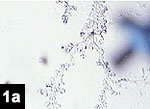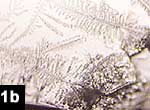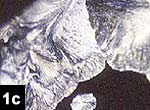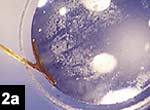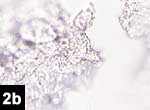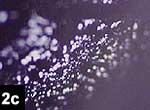Viscoelastic crystallization observed on IOLs in vitro
A laboratory study evaluated viscoelastic crystallization patterns on IOLs, in order to compare with those seen on explanted IOLs.
SALT LAKE CITY – Patterns of viscoelastic crystallization created on IOLs in a lab experiment were similar to patterns seen on some IOLs explanted due to optic opacifications, according to a recent study. The patterns were developed on the optic surfaces of various IOL materials with a number of viscoelastic substances, the study authors said.
The study was presented by Rupal Trivedi, MD, at the American Society of Cataract and Refractive Surgery meeting in Philadelphia. It was directed by Liliana Werner, MD, PhD, and David J. Apple, MD, and performed with the collaboration of Andrea M. Izak, MD, and Suresh K. Pandey, MD.
A total of 16,173 IOLs or IOL-related specimens were accessioned by the Center for Research on Ocular Therapeutics and Biodevices between January 1988 and January 2001. Of these, approximately 9,000 specimens were lenses that were explanted due to complications such as error in IOL power calculation, IOL decentration, various forms of IOL-related opacification and several others. They were submitted to the laboratory randomly from ophthalmic surgeons nationwide and overseas.
The authors observed significant amounts of crystalline material that exhibited birefringence under polarizing microscopy on the surfaces of some of the explanted lenses. These lenses were divided into two groups: lenses explanted due to complications unrelated to optical opacification, such as error in IOL power calculation, IOL decentration, etc. (figures 1a, 1b, 1c); and lenses explanted because of the presence of the crystalline material itself, which caused optical opacification significant enough to require explantation (figures 2a, 2b, 2c).
“In the first group, the crystals observed on the surfaces of the lenses probably correspond to crystallization of solutions used during the lens explantation procedures, without any clinical relevance,” Dr. Werner said.
In vitro study
|
|
|
The researchers designed an in vitro study to evaluate the variety of crystallization patterns caused by different viscoelastics on the surfaces of IOL optic materials. The study included numerous viscoelastics (sodium hyaluronate in different concentrations, chondroitin sulfate/sodium hyaluronate and hydroxypropylmethylcellulose) and IOL optic materials (PMMA, hydrophobic and hydrophilic acrylic, and silicone).
A volume of 0.1 mL of each viscoelastic solution was placed in a Petri dish and stirred with 0.5 mL of saline. Then, 0.1 mL of this mixture was placed on the anterior surface of the IOLs. The solution on the anterior surface of each IOL optic was allowed to dry overnight at room temperature. The pattern of crystallization was then assessed by light microscopy, including polarized light. Photomicrographs were taken for documentation at different intervals.
In general, crystallization of all of the viscoelastics composed of sodium hyaluronate presented a similar pattern regardless of the IOL material. This had a fern-like appearance, formed by the confluence of small square crystals. Viscoelastics composed of chondroitin sulfate/sodium hyaluronate and hydroxypropylmethylcellulose presented slightly different fern-like patterns from those created by the solutions that were exclusively composed of sodium hyaluronate.
The only crystallization pattern completely different from the previously described ones was that of chondroitin sulfate/sodium hyaluronate when placed on the surface of silicone IOLs. In this case, the small square crystals assumed mostly a more compact appearance, without general formation of the fern-like structures. Complete crystallization of viscoelastics on the anterior surfaces of the lenses occurred after 2 to 3 hours. Crystallization of chondroitin sulfate/sodium hyaluronate on the surface of silicone lenses required more than 5 hours. The experiment with chondroitin sulfate/sodium hyaluronate and silicone IOLs was repeated three times in order to confirm these observations.
The fern-like crystallization patterns obtained in the study corresponded to those of the crystalline deposits observed on the surfaces of lenses explanted due to complications unrelated to optical opacification. Thus, viscoelastics used during the explantation procedures probably crystallized on the surfaces of the IOLs sent in a dry state to Dr. Apple’s Center. Also, on first inspection, the individual small crystals forming the fern-like structures obtained in the study appeared to be similar to the crystals found on the surfaces of lenses explanted because of the presence of the crystalline material. These later were nevertheless not organized in the same pattern.
Further study needed
Researchers involved in the study agree that additional studies are necessary to determine whether residual viscoelastic material may crystallize on IOL surfaces within the eye and cause opacification severe enough to require explantation of the lens.
“Without any doubt this issue needs further investigation as the experiment presented here was not performed in conditions that simulate the aqueous environment,” Dr. Trivedi said.
In any case, viscoelastic should be thoroughly removed at the end of the cataract procedure because of the risk of increased IOP, Dr. Apple said.
For Your Information:
- Dr. Apple’s laboratory has been transferred to Salt Lake City, Utah. Liliana Werner, MD, PhD, and David J. Apple, MD, can be reached at John A. Moran Eye Center, 5th floor, 50 North Medical Drive, Salt Lake City, UT 84132; (801) 581- 8136; fax: (801) 581-3357; e-mail: liliana.wernerl@hsc.utah.edu; trivedi@musc.edu. The authors have no direct financial interest in the products mentioned in this article, nor are they paid consultants for any companies mentioned.

